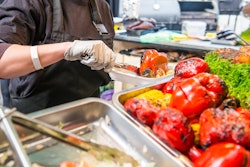
2023 has been a particularly taxing time for the extended retail food value chain. The year began burdened with the lingering effects of the COVID-19 pandemic and has since seen the sector’s resiliency continually tested through a series of natural and manmade (weather, war and more) events. Yet technology marches on through it all. Here are a few critical trends that successful retailers, wholesalers and manufacturers must address now or risk having to play catchup later.
Shift from online-only to hybrid. Expect food customers to double down on their shift from online-only to hybrid or multichannel shopping, in which they do most, if not all, of their research online and then make their purchases online or in the store. This trend accelerated in the first half of 2023, reflecting consumers’ post-pandemic desire to go out and interact with live people. And with consumer shopping zeal only marginally dimmed by high (though rapidly falling) inflation, they are still consuming at growing rates.
To meet this trend, more retailers, wholesalers and manufacturers are adopting “buy online, pick up in store” (BOPIS) policies. Many of these stores are adding digital components—such as interactive kiosks and touchscreen displays—that not only boost on-site sales and efficiency, but later, automatically inform shoppers of relevant promotions and the like. And this trend works its way back up the supply chain, impacting both distributors and suppliers and the way product gets to the ultimate consumer.
The caveat here is that many of these same customers will be doing less discretionary shopping overall due to their ongoing economic worries as well as eye-popping delivery costs, which often rise faster than the cost of goods themselves. Winners in the near term will be value-conscious, membership-only big-box retail stores, mass merchants, dollar stores and the like, while many of the pandemic’s winners—such as traditional supermarket chains and home goods—should have already buckled up for a bumpy ride ahead. Also, the more nimble distributors and suppliers that can best deliver demanded product at the right place and time will prevail over competitors relying on outdated technology.
Influx of AI. Food companies are leaning ever more heavily on artificial intelligence (AI), especially for demand forecasting and inventory management—managing omnichannel inventories and rationalizing localized assortments—as well as promotion optimization and customer engagement. IT is absolutely essential here. Engineers create the AI-powered algorithms that analyze customer behavior, identify sales patterns, and feed predictive analytics engines that are used to forecast demand, optimize inventory levels, manage the supply chain, reduce waste and so much more. AI-led data analytics is literally transforming the retail food industry. That wouldn’t be happening without the massive technological leaps IT makes possible.
Food retailers, wholesalers and manufacturers are continuously improving their forecasting engine’s precision in alignment with these current trends, such as utilizing state-of-the-art machine learning techniques to support various omnichannel capabilities, including ship-from-store and BOPIS.
Moreover, they are moving fast to incorporate generative AI, including OpenAI’s ChatGPT, into their processes for both marketing and merchandising, as well as their back-office operations like supply chain management. Some leading food retailers, wholesalers and manufacturers are now deploying ChatGPT to quickly answer use case-specific questions.
Look for tech vendors to keep introducing new AI-powered products that handle a broader spectrum of use cases, such as sharpening their holiday pricing and shoring up their year-end margins.

















